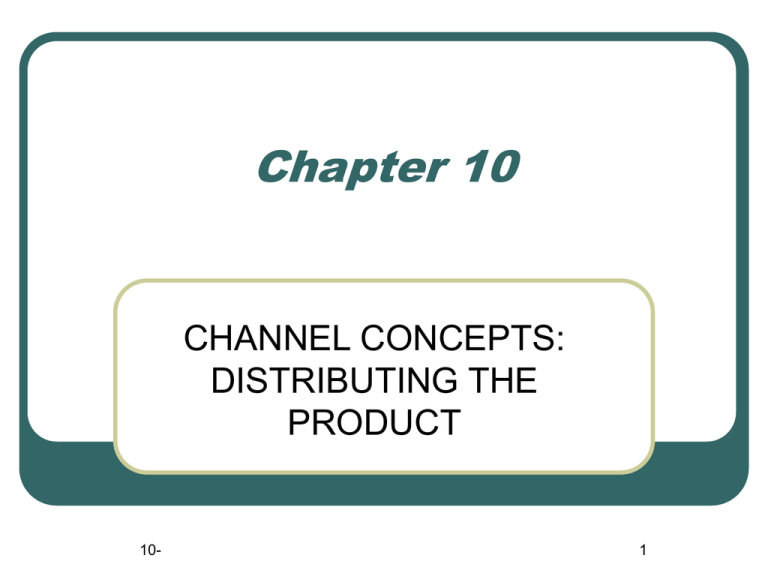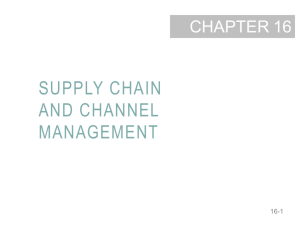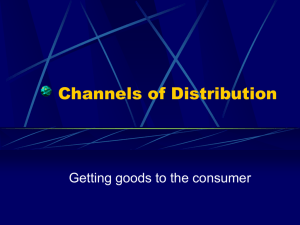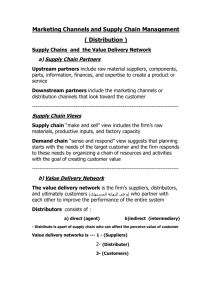Chapter 10
advertisement

Chapter 10 CHANNEL CONCEPTS: DISTRIBUTING THE PRODUCT 10- 1 • Role of distribution channels • Methods used in organizing channels • Management of underlying behavioral dimensions present in most channels • Elements of a channel strategy • Tasks assigned to various channel institutions 10- 2 • Primary purpose: creation of time and place utility • Extremely complex process, often the only element of marketing where cost savings still possible • Channel selection is a dynamic part of marketing planning • Channel needs to be managed to work • Composed of individuals and groups with unique traits that may conflict, may need to be motivated 10- 3 • Exchange: sale of the product to various members of the distribution channel • Physical distribution: moves products through the exchange channel, simultaneously with title and ownership • Key role: satisfying customer’s and achieving profit for the firm • Customer satisfaction: maximizing time and place utility to the organization’s suppliers, intermediate and final customers 10- 4 • Barter to industrial specialization in goods products to service products • Marketing channel: sets of interdependent organizations involved in the process of making a product/service available for use/consumption; providing a payment mechanism for the provider • Institutions: some under producer’s control, some not; but all must be recognized, selected, integrated into efficient arrangement • Process: continuous management, monitoring, reappraisal • Objectives: make an acceptable profit 10- 5 • Multiple linkages that tie channel members and other agencies together • Product • Negotiation • Ownership • Information • Promotion 10- 6 Movement of the physical product from the manufacturer through all the parties who take physical possession of the product until it reaches the ultimate consumer e.g., transportation company to public warehouse to supermarkets 10- 7 Institutions associated with the actual exchange process e.g., bottlers and beer distributors to supermarkets 10- 8 Shows the movement of title through the channel e.g., from bottlers and beer distributors to supermarkets 10- 9 Identifies the individuals who participate in the flow of information either up or down the channel e.g., from transportation company to public warehouse to bottlers and distributors to supermarkets 10- 10 Flow of persuasive communication in the form of advertising, personal selling, sales promotion and public relations e.g., from advertising agency to bottlers and beer distributors to supermarkets 10- 11 • Producer of the product – craftsman, manufacturer, farmer or other extractive industry producer • User of the product – individual, household, business buyer, institution, government • Certain middlemen at the wholesale or retail level 10- 12 • Transactional: buying, selling, risk assumption • Logistical: assembly, storage, sorting, transportation • Facilitating: postpurchase service and maintenance, financing, information dissemination, channel coordination or leadership 10- 13 • While channel institutions can be eliminated or substituted, the functions of those institutions cannot be eliminated • All institutional members are part of many channel transactions at any given point in time • Satisfaction of transactions is based on routinization benefits • When available middlemen are incompetent, unavailable or the producer feels he can perform the task better, the best channel arrangement is direct, from the producer to the ultimate user • Service marketers face the problem of delivering their product in the form, at the place and time their customer demands, solutions: banks- ATMs 10- 14 Members and non-members Members perform negotiation functions, participate in negotiation and/or ownership; non-members do not Producer and manufacturer Retailing: department stores, chain stores, supermarkets, discount houses, warehouse retailing, franchises, planned shopping centers/malls Non-store Retailing: home-selling, automated vending, mail order, online marketing, catalog marketing, kiosks Wholesaling: independent, part of vertical marketing system 15 10- • Firms extract, grow or make products; vary in size from one-person operation to those that employ several thousands people, generate billions in sales • Channel members can be useful in designing, packaging, pricing, promoting of the product through the most effective channels 10- 16 • All activities needed to market consumer goods, services to the ultimate consumer who are motivated to buy for individual/family needs e.g., computer at Circuit City • Sales also made through means other than stores 10- 17 • Department stores: wide product mixes e.g., hardware, clothing, each product in different sections in the store e.g., Sears • Chain stores: large size enable buying of a wide variety of items in large quantity discounts; prices lower than small competitors; convenient locations; increased market share e.g., Pizza Hut 10- 18 • Large, self-service stores with central checkout facilities; extensive line of food items, often nonfood products e.g., Safeway • Mass-merchandising, lowcost distribution methods • Availability of large assortments of a variety of goods like food, household cleaning, maintenance products at a minimal price 10- 19 • Cut-rate retailers e.g., Walmart • Emphasis on price as the main sales appeal • Merchandise assortments are broad including hard and soft goods, but limited to most popular items, colors and sizes • Large self-service operations with long hours, free parking, relatively simple fixtures 10- 20 Warehouse: • Relatively new type • Catalog showrooms largest type e.g., Costco 10- Franchise: • Response to competition from large chain stores • Only sell the products of the franchiser • Operate the business to some extent as the manufacturer wishes • e.g., dealer of Chevrolet 21 10- Wide assortment of products, many alternatives in one location Regional : larger centers that have one or more major department stores as major tenants Community: moderately sized with junior department stores Neighborhood: small with the key store a supermarket Local clusters: shopping districts grown over time around key intersections, courthouses String street locations: along major traffic routes Isolated locations: freestanding sites not necessarily in heavy traffic areas; use promotion to attract shoppers 22 • In-home selling: pre-select prospects, cold calls e.g., Avon • Demonstration party: one customer acts as host and invites friends e.g., Tupperware 10- 23 • Mail order: product description through flyer, catalog convenience, larger geographic coverage, limited service e.g., CD Now • Catalog: companies mail one or more product catalogs to select addresses that have a high likelihood of placing an order e.g., J.C. Penny’s • Kiosks: “customer-order placing machines” located at airports, stores e.g., Florsheim Shoe Company 10- 24 Coin-operated, selfservice machines, variety of products, services at convenient locations e.g., banking transactions 10- 25 • Commercial online channels: both retailer and consumer need computer and modem; companies set up online information and marketing services that can be assessed by those who have signed up and paid a monthly fee • Internet: global web that allows instantaneous and decentralized global communication; users can send e-mails, exchange views, shop for products, access real-time news; marketers can use e-mails, participate in forums, newsgroups, bulletin boards, place ads online, create electronic storefront 10- 26 • All activities required to market goods, services to businesses, institutions, industrial users motivated to buy for resale or to produce and market other goods, services e.g., a bank buying computer for data processing 10- 27 • Warehousing: receiving, storing, packaging • Inventory control and order processing: track physical inventory, manage its composition and level, process transactions • Transportation: arranging physical movement of goods • Information: supplying information about markets to producers and about products and suppliers to buyers • Selling: personal contact with buyers • Planning, financing, developing marketing mix 1028 • Full-service merchandise: general, limited-line • Limited service merchant: cash and carry, rack jobbers, drop shippers, mail orders • Agents and brokers: agents – buying agents, selling agents, commission merchants, manufacturer’s agents; brokers – real estate, food, other products • Manufacturer’s sales • Facilitator: warehouses, finance companies, transportation companies, trade marts 10- 29 • Take title to the merchandise; assume the risk involved in an independent operation; buy and resell products; offer a complete range of services • Same as full but offer a limited range of services 10- 30 • Do not take title to the merchandise; bring buyers and sellers together; negotiate the terms of the transactions • Agents merchants represent either the buyer or seller, usually on a permanent basis • Brokers bring parties together on a temporary basis 10- 31 • Owned directly by the manufacturers; performs wholesaling functions for the manufacturer • Perform some specialized functions such as financing or warehousing; to facilitate the wholesale transactions; may be independent or owned by producer or buyer 10- 32 • Provide the bridge between production activities and markets that are spatially and temporally separated • Process of strategically managing the movement and storage of materials, parts, finished inventory from suppliers, between enterprise facilities, and to customers • Valuable marketing tool to stimulate consumer demand 10- 33 • Defining the physical distribution (P.D.) standards that channel members want • Making sure the proposed P.D. program designed by an organization meets the standard of channel members • Selling channel members on P.D. programs • Monitoring the results of P.D. once it has been implemented 10- 34 • Conventional channels • Vertical Marketing systems • Horizontal channel systems 10- 35 • Group of independent businesses, each motivated by profit, having little concern about any other member of the distribution sequence • No all-inclusive goals • Assignment of tasks and evaluation process are totally informal; can create deficiencies 10- 36 • Solution to problems of conventional networks • When a member (usually the manufacturer) assumes a leadership role and attempts to coordinate the efforts of the channel so that mutually beneficial goals like better profits, product exposure, can be attained 10- 37 • Administered: informally guided by goals and programs developed by one or a limited number of firms in the existing channel; channel captain: administrative skills and power of one individual may be the driving force of the channel e.g., Xerox; problems of polarization • Contractual: members formalize relationship; provides additional control; spells out marketing functions • Corporate: members on different levels are owned and operated by one organization; forward (own various intermediaries e.g., Dannon Yogurt) or backward (retailer who takes over wholesaling and manufacturing e.g., Sears) integration 10- 38 • When two or more companies do not have the capital, technical or production know-how to effectively market their products alone • Establish temporary or quasi-permanent relationship in order to work with each other to create the channel mechanism needed to reach their target 10markets 39 • Analyze the customer • Establish objectives • Specify distribution tasks • Evaluate and select channel alternatives • Evaluating channel member performance • 10-Correct or modify 40 • Whom to sell the merchandise immediately? • Who is the ultimate buyer and user? • Discover buying specifications of the ultimate user e.g., comparison of prices, willingness to bear with inconvenience • Helps to decide on the type of wholesaler or retailer through which a product should be sold • Discover buying specifications of resellers 10- 41 • Growth in sales: reach new markets, and/or increase sales in existing one • Maintenance or improvement of market share: educate or assist members in their efforts to increase the amount of product they handle • Achieve a pattern of distribution: structure to achieve certain time, place, form, information utilities • Create an efficient channel: improve performance by modifying flow mechanisms 10- 42 • Fully identify tasks, define how tasks can change with situation, assign costs • Provide delivery within a specific period of time • Offer adequate storage space • Provide credit to other intermediaries • Facilitate a product return network • Provide readily available inventory (quantity, type) • Provide for absorption of size and grade obsolescence 10- 43 Bases: • Number of levels: two to several • Intensity of the levels: actual number of components • Types of intermediaries at each level • Application of selection criterion to channel alternatives 10- 44 • Exclusive: single/few outlets; high dealer loyalty, sales support; greater control; limits potential sales volume; success dependent on the ability of single intermediary e.g., Ethan Allen • Intensive: maximum number of intermediaries; increased sales, recognition, impulse purchasing; low price, margin, small order sizes; difficult to stimulate and control large number of intermediaries e.g., Candies • Selective: intermediary strategy, outlets number dependent on market potential, density of population, dispersion of sales, competitor’s policies; some strengths and weaknesses of the other two; difficult to determine optimal number of intermediaries e.g., 1045 Baskin Robbins • Passive to active; very negative, based on fear and punishment, to very positive, based on encouragement and reward • Manufacturer: if control of the product (merchandising, repair) is critical and if the design and redesign of the channel is best done by the manufacturer • Wholesaler: where the manufacturers and retailers have remained small in size, large in number, relatively scattered geographically, are weak in finance, marketing expertise • Retailer: when product development and demand stimulation are relatively unimportant, personal attention to the customer is important 10- 46 • Sales popular criteria: current vs. historical; comparison with other members; comparison of member’s sales with predetermined quotas • Maintenance of adequate inventory • Selling capabilities • Attitudes of intermediaries toward product • Competition from other intermediary, from other product line carried by manufacturer’s own channel members 10- 47 • Role: clearly defining role/tasks prescriptions of various participants and communicating them in order to achieve desired results • Communication: sending and receiving information relevant to operation; detect behavioral problems that inhibit effective flow of information and resolve them • Conflict: personal and direct; often confrontational; manage by establishing mechanisms to detect, appraise the effect of and resolve conflict • Power: willingness to use force in a relationship; means of influencing/controlling behavior of the other party 10- 48






